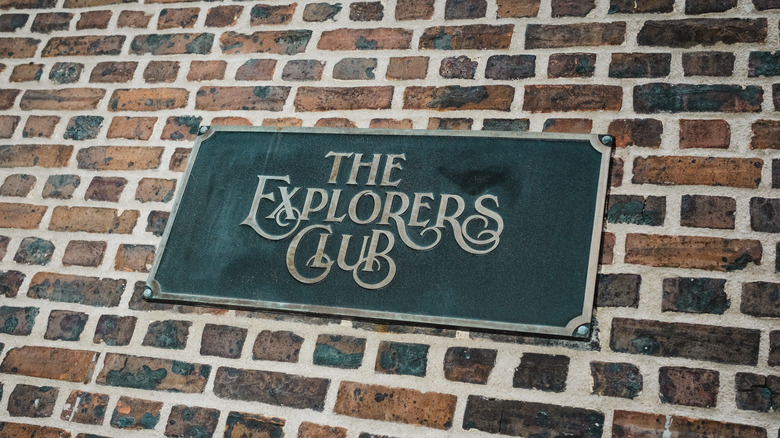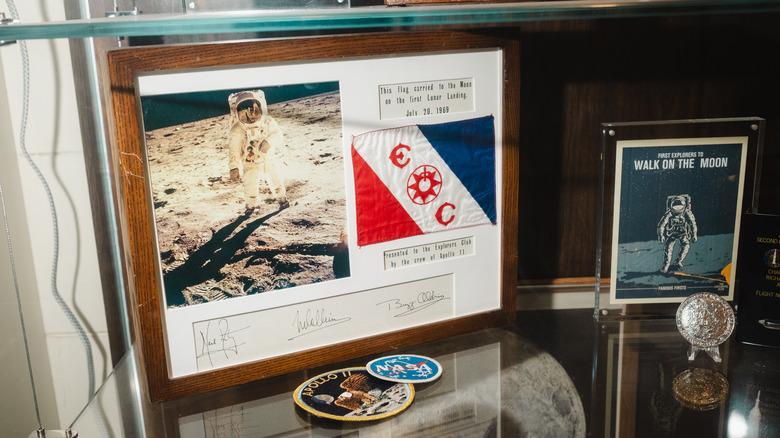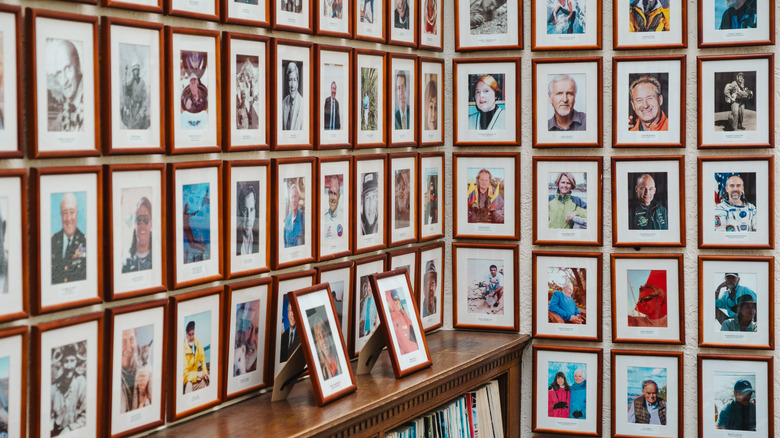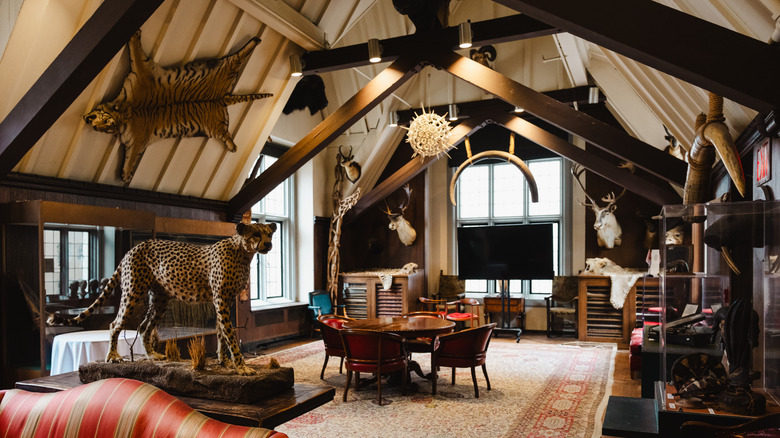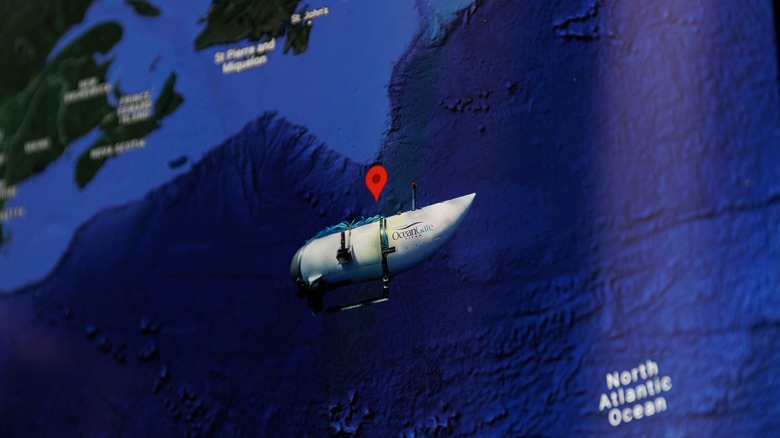The Untold Truth Of The Explorers Club
Editor's note: A previous version of this article said Stockton Rush was a member, but he was not. The article has been corrected to reflect this.
An elite club established for the intermingling of explorers, scientists, and astronauts sounds like something from the 19th century, or the basis of a story by the likes of Jules Verne or Arthur Conan Doyle. But The Explorers Club really exists, and today it boasts some of the world's most intrepid boundary-pushers among its approximately 3,500 members.
Founded in Manhattan in 1904 and incorporated the following year, the Explorers Club today is made up of 34 chapters that span the globe. However, its headquarters remain in New York, where the club regularly hosts events, including dinners and speeches of some of the most interesting explorers to walk the earth. The club has certainly maintained its sense of prestige well into the 21st century. However, a spate of recent feuds and scandals seem likely to have collectively tarnished the image of the institution and raised questions about the character of its members.
A protected flag
The Explorers Club counts among its members some of the greatest figures in the history of exploration, including Teddy Roosevelt, Neil Armstrong, Edmund Hillary, and Jane Goodall. But while portraits of such intrepid explorers line the rooms and corridors of the club's Manhattan headquarters, their achievements are marked in another manner. Also adorning the walls are scores of Explorers Club flags, which are vital to the club's brand. Typically, explorers whose trips are backed by the club — which operates a yearly expedition fund of $175,000 — can apply to take one of the club's flags with them. The selection criteria are highly exclusive, with the club's Flag and Honours Committee only allowing the flag to be taken on expeditions of particular interest and renown.
An Explorer's Club flag can also be retired, but only if it does something "extraordinary," according to executive director Will Roseman (via YouTube). One such flag has been taken to both the Mariana Trench and the peak of Everest, while another went to the moon with the Apollo missions.
A membership problem
There are countless people out there who consider themselves explorers of one type or another — those who view life as an adventure and seek to see as much of the world as possible with the time they have. However, in the world of The Explorers Club, the definition of "explorer" is surprisingly specific.
As their website makes clear, to become a member of The Explorers Club you have to be engaged in a scientific pursuit that benefits mankind — an activity in which the travel itself is a byproduct. However, those who can't meet these requirements but nevertheless want to associate themselves with the prestigious New York club can do so. All they have to do is apply to be a "Friend of the Explorers Club," and they will pay dues to the club just as full members do. But some ex-members have criticized the organization for failing to adhere to its stated definition of exploration, with one writing in an article on Explorers Web that some members were admitted after taking Arctic cruises.
In recent years The Explorers Club has also come under fire for its strongly upheld exclusiveness, with critics highlighting a lack of diversity among its members. According to a 2021 Bloomberg feature, at the time around 90% of the club's members were white, and 71% were male. The club is also made up predominantly of members from wealthy backgrounds. One Black member, J. Robert Harris, recalls experiencing racism at the club when he joined in the 1990s, but as of 2021 he was active in the club's drive to diversify its membership base.
Feuding has damaged the brand
Despite the illustrious names and feats of daring that are often associated with The Explorers Club, in recent years the organization has been hampered by numerous articles detailing bitter feuds within its leadership. This controversy has reportedly led to several high-profile members allowing their memberships to lapse, which in itself has begun to tarnish the club's reputation.
One scandal that took hold of the club in 2011 involved the then-president, German businesswoman Lorie Karnath. According to Outside, she was accused of challenging the Flag and Honours Committee to ensure it rewarded one of her allies with the prestigious annual Explorers Medal. She in turn argued that she had attracted enemies within the club for attempting to modernize it in a short period of time. More recently, the club's name has been dragged further through the mud by revelations of affairs and accusations of sexual harassment by a later president, Richard Wiese, per Page Six.
Other issues within The Explorers Club revolve around commercial interests and corporate sponsorship. Per Explorers Web, some say these factors have become central to the club's operations at the expense of scientific endeavors.
A club tragedy
Explorers are a daring bunch, often putting their lives on the line to break new ground in some of the most inhospitable environments on Earth. However, The Explorers Club faced tragedy in the summer of 2023 when details emerged of a disastrous expedition undertaken by club friend Stockton Rush, the founder of American submersible company Oceangate.
In June of that year, it was reported that Rush had taken a group of four paying customers — including two club members, Hamish Harding and Paul-Henri Nargeolet — down to the site of the Titanic wreckage. They made the trek in a low-cost submersible of his own design but lost contact with the surface soon after descending. After the horrifying news broke, The Explorers Club drew on its vast network of exploration experts to aid the rescue attempt. However, the club's president, Richard Garriott de Cayeu, told National Geographic that attempts to deploy robots to bring the craft to the surface were hampered by bureaucracy.
Tragically, it was later revealed that the sub had imploded under the pressure of the water due to flaws in its design, killing everyone on board. In the aftermath, Rush — who had previously given a lecture at the Explorers Club justifying his design (via YouTube) — came under intense scrutiny, with experts in the field of marine exploration noting that they had sounded the alarm about his lack of adherence to safety checks.
Out of this world
Despite recent controversy undoubtedly affecting the public image of The Explorers Club, the organization remains as ambitious as ever. Clearly, it's seeking to maintain its position at the vanguard of human exploration. Specifically, The Explorers Club plans to build on its reputation for boundary-pushing — as evidenced by its members' various explorations of the North and South Poles, the Mariana Trench, Everest, and the moon — by preparing for a future journey to Mars. Indeed, a plaque outside the New York headquarters has space reserved for when this dream becomes a reality.
But Explorers Club members are already active in making preparations for the greatest expedition humanity has undertaken so far. As Business Wire reports, an Explorers Club flag mission involved a team of experts traveling to the Grímsvötn volcano in Iceland to test space suit prototypes to ascertain what might best stand up to the extreme conditions on the red planet.
